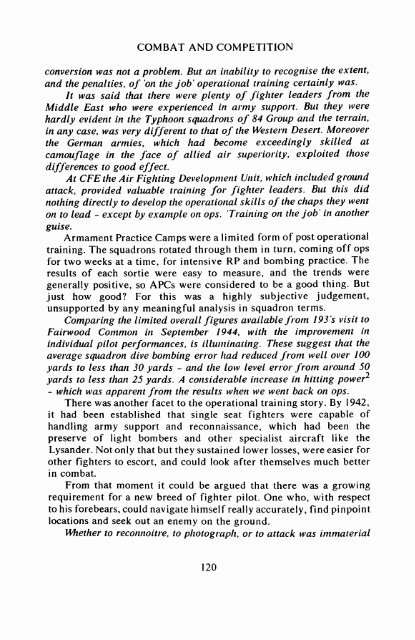COMBAT AND COMPETITION.pdf - Lakes Gliding Club
COMBAT AND COMPETITION.pdf - Lakes Gliding Club
COMBAT AND COMPETITION.pdf - Lakes Gliding Club
You also want an ePaper? Increase the reach of your titles
YUMPU automatically turns print PDFs into web optimized ePapers that Google loves.
<strong>COMBAT</strong> <strong>AND</strong> <strong>COMPETITION</strong><br />
conversion was not a problem. But an inability to recognise the extent,<br />
and the penalties, of 'on the job' operational training certainly was.<br />
It was said that there were plenty of fighter leaders from the<br />
Middle East who were experienced in army support. But they were<br />
hardly evident in the Typhoon squadrons of 84 Group and the terrain,<br />
in any case, was very different to that of the Western Desert. Moreover<br />
the German armies, which had become exceedingly skilled at<br />
camouflage in the face of allied air superiority, exploited those<br />
differences to good effect.<br />
At CFE the Air Fighting Development Unit, which included ground<br />
attack, provided valuable training for fighter leaders. But this did<br />
nothing directly to develop the operational skills of the chaps they went<br />
on to lead - except by example on ops. 'Training on the job' in another<br />
guise.<br />
Armament Practice Camps were a limited form of post operational<br />
training. The squadrons rotated through them in turn, coming off ops<br />
for two weeks at a time, for intensive RP and bombing practice. The<br />
results of each sortie were easy to measure, and the trends were<br />
generally positive, so APCs were considered to be a good thing. But<br />
just how good? For this was a highly subjective judgement,<br />
unsupported by any meaningful analysis in squadron terms.<br />
Comparing the limited overall figures available from 193's visit to<br />
Fairwood Common in September 1944, with the improvement in<br />
individual pilot performances, is illuminating. These suggest that the<br />
average squadron dive bombing error had reduced from well over 100<br />
yards to less than 30 yards - and the low level error from around 50<br />
yards to less than 25 yards. A considerable increase in hitting power<br />
- which was apparent from the results when we went back on ops.<br />
There was another facet to the operational training story. By 1942,<br />
it had been established that single seat fighters were capable of<br />
handling army support and reconnaissance, which had been the<br />
preserve of light bombers and other specialist aircraft like the<br />
Lysander. Not only that but they sustained lower losses, were easier for<br />
other fighters to escort, and could look after themselves much better<br />
in combat.<br />
From that moment it could be argued that there was a growing<br />
requirement for a new breed of fighter pilot. One who, with respect<br />
to his forebears, could navigate himself really accurately, find pinpoint<br />
locations and seek out an enemy on the ground.<br />
Whether to reconnoitre, to photograph, or to attack was immaterial<br />
120

















